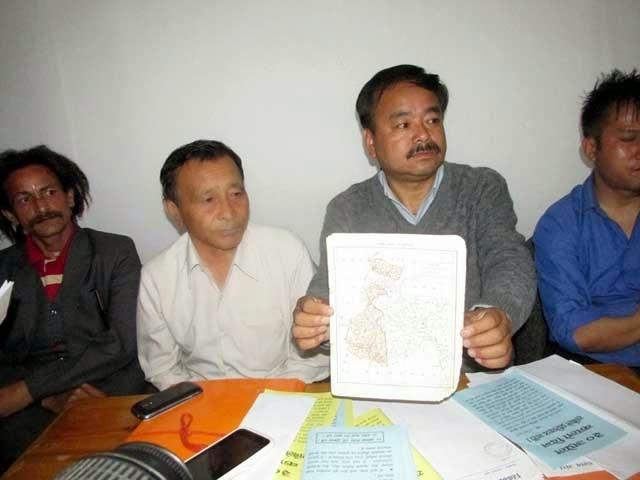Why Has a Little-known Group Labelled April 30 A Black Day?

Image Courtesy: Mungpoo News
The Sikkim Darjeeling Ekikaran Manch (SDEM) is observing April 30 as a 'black day', or kaalo diwas. The organisation has been observing this day as a black day since 2015. The announcement, this year, was made on April 26. Speaking to The Himalayan Beacon, central committee members of SDEM John Rai and Ujwal Rai, outlined the reasons for this observance. In 1954 on this day, Darjeeling district was officially merged with West Bengal. This was done without consulting any of the people living in the district. Darjeeling district, including some parts of the adjoining Terai were originally a part of Sikkim. Ujwal Rai mentioned that there is no dearth of people from Darjeeling who have done history or political science honours; some of them have even been gold medallists. However, most people still have little understanding of the history of Darjeeling. Ujwal Rai said, “Hamile hamro history padhnu chai birseyo(We have forgotten to study our own history).” John Rai stated that the organisation does not view the people of West Bengal as enemies, nor are they antagonistic towards the union government or the government of West Bengal, or any political party. But, it needs to be understood that the history of Darjeeling is complicated.
Darjeeling was first a part of Sikkimese territory; however, in the course of the Nepal-Sikkim wars, the Kingdom had been almost entirely overrun and the then Chogyal(king) had fled to Tibet. Following the Anglo-Gorkha war, the East India Company signed the Treaty of Sugauliwith the Kingdom of Nepal, and subsequently the Treaty of Titaliawith the Kingdom of Sikkim. The treaty with Nepal resulted in Nepal ceding large amounts of territory in the West, South and East to the British. The territory ceded in the East – which included Sikkim – was the subject of the Titalia treaty. Through this treaty, the British returned all the lands previously conquered by Nepal, in exchange for Sikkim's support for the British. Sikkim should not allow Europeans to settle within its borders, and it should not harbour absconding offenders, were some of the terms of the treaty. Both the treaties, however, had stipulated that in the instance any dispute between Sikkim and Nepal, the matter would be adjudicated by the British.
The East India Company had ceded the Terai lands in Morang to Sikkim through a Sanad, wherein Sikkim only had revenue rights over the territory. Darjeeling, however, was given to the British as a grant to build a 'sanatorium'. This, as history shows, was not what actually happened. The terms of the grant of Darjeeling were understood differently by the British and the Chogyal. The Chogyalsaw the grant as one for raising a few buildings, whereas the British saw it as a perpetual cession of territory. As time bore on due to open hostility between the two parties, the British government finally annexed Darjeeling and annulled the Sanad for the Terai. The matter was finally resolved, when the British government drafted a new agreement – a lease. Thus, the Chogyal received an annual sum from the British government of India for Darjeeling.
In 1947, when British Paramountcy lapsed, Sikkim assumed that Darjeeling would be returned. Thethen Chogyal, Sir Tashi Namgyal had made several representations to the government of India in this regard. However, by then, Darjeeling had a world famous tea industry. This expectation was never realised. However, the Indo-Sikkim Friendship Treaty, 1950 under Article X made a provision for an annual payment of Rs. three lakh, which continued until the 'merger' in 1975. Though, the treaty provision stated this was out of 'friendship', one could construe this as a tacit acceptance of the lease, despite Article I annulling all previous treaties. Finally in 1954, The Absorbed Areas (Laws) Act was passed. Through this Act, Darjeeling officially became a part of West Bengal. Lumping Darjeeling with West Bengal was done despite the fact that the Hillmen's Association in 1907 had submitted a memorandum regarding a separate administration for the hills.
Though the SDEM is not a big voice in the politics of the hills, the issue regarding the democratic consent of the people is an important one. In 1954, there was no vote regarding the status desired by the people of the hills. Their political destiny since then has been shaped by the whims of 'experts', till the first uprising in the late 1980s. The result is of course the injection of ethnic and linguistic politics in the hills. The several rounds of agitation the hills witness periodically are only a symptom of a desire for federal autonomy.
Get the latest reports & analysis with people's perspective on Protests, movements & deep analytical videos, discussions of the current affairs in your Telegram app. Subscribe to NewsClick's Telegram channel & get Real-Time updates on stories, as they get published on our website.
























